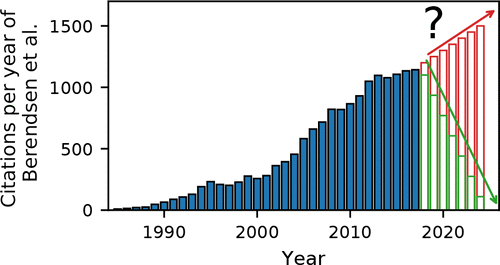当前位置:
X-MOL 学术
›
J. Chem. Theory Comput.
›
论文详情
Our official English website, www.x-mol.net, welcomes your
feedback! (Note: you will need to create a separate account there.)
Anomalous Effects of Velocity Rescaling Algorithms: The Flying Ice Cube Effect Revisited
Journal of Chemical Theory and Computation ( IF 5.7 ) Pub Date : 2018-08-03 00:00:00 , DOI: 10.1021/acs.jctc.8b00446 Efrem Braun 1 , Seyed Mohamad Moosavi 2 , Berend Smit 1, 2
Journal of Chemical Theory and Computation ( IF 5.7 ) Pub Date : 2018-08-03 00:00:00 , DOI: 10.1021/acs.jctc.8b00446 Efrem Braun 1 , Seyed Mohamad Moosavi 2 , Berend Smit 1, 2
Affiliation

|
The flying ice cube effect is a molecular dynamics simulation artifact in which the use of velocity rescaling thermostats sometimes causes violation of the equipartition theorem, affecting both structural and dynamic properties. The reason for this artifact and the conditions under which it occurs have not been fully understood. Since the flying ice cube effect was first demonstrated, a new velocity rescaling algorithm (the CSVR thermostat) has been developed and become popular without its effects on the equipartition theorem being truly known. Meanwhile, the use of simple velocity rescaling and Berendsen (weak coupling) thermostat algorithms has not abated but has actually continued to grow. Here, we have calculated the partitioning of the kinetic energy between translational, rotational, and vibrational modes in simulations of diatomic molecules to explicitly determine whether the equipartition theorem is violated under different thermostats and while rescaling velocities to different kinetic energy distributions. We have found that the underlying cause of the flying ice cube effect is a violation of balance leading to systematic redistributions of kinetic energy under simple velocity rescaling and the Berendsen thermostat. When velocities are instead rescaled to the canonical ensemble’s kinetic energy distribution, as is done with the CSVR thermostat, the equipartition theorem is not violated, and we show that the CSVR thermostat satisfies detailed balance. The critical necessity for molecular dynamics practitioners to abandon the use of popular yet incorrect velocity rescaling algorithms is underscored with an example demonstrating that the main result of a highly cited study is entirely due to artifacts resulting from the study’s use of the Berendsen thermostat.
中文翻译:

速度缩放算法的反常效应:重新讨论了飞冰块效应
飞冰块效应是一种分子动力学模拟伪像,其中使用速度缩放的恒温器有时会违反等分定理,从而影响结构和动力学特性。此伪影的原因及其发生的条件尚未完全了解。自从首次证明了飞行冰块效应以来,就开发了一种新的速度重缩放算法(CSVR恒温器),并且在不真正知道其对均分定理的影响的情况下变得很流行。同时,简单的速度调整和Berendsen(弱耦合)恒温器算法的使用并没有减少,但实际上一直在增长。在这里,我们计算了动能在平移,旋转,双原子分子的模拟中的振动和振动模式,以明确确定在不同的恒温器下以及将速度重新缩放为不同的动能分布时是否违反了等分定理。我们已经发现,飞冰块效应的根本原因是违反平衡,导致在简单的速度调整和Berendsen恒温器的作用下系统化地重新分配了动能。当像CSVR恒温器一样将速度重新调整为规范合奏的动能分布时,不违反均分定理,并且我们证明CSVR恒温器满足详细的平衡。
更新日期:2018-08-03
中文翻译:

速度缩放算法的反常效应:重新讨论了飞冰块效应
飞冰块效应是一种分子动力学模拟伪像,其中使用速度缩放的恒温器有时会违反等分定理,从而影响结构和动力学特性。此伪影的原因及其发生的条件尚未完全了解。自从首次证明了飞行冰块效应以来,就开发了一种新的速度重缩放算法(CSVR恒温器),并且在不真正知道其对均分定理的影响的情况下变得很流行。同时,简单的速度调整和Berendsen(弱耦合)恒温器算法的使用并没有减少,但实际上一直在增长。在这里,我们计算了动能在平移,旋转,双原子分子的模拟中的振动和振动模式,以明确确定在不同的恒温器下以及将速度重新缩放为不同的动能分布时是否违反了等分定理。我们已经发现,飞冰块效应的根本原因是违反平衡,导致在简单的速度调整和Berendsen恒温器的作用下系统化地重新分配了动能。当像CSVR恒温器一样将速度重新调整为规范合奏的动能分布时,不违反均分定理,并且我们证明CSVR恒温器满足详细的平衡。









































 京公网安备 11010802027423号
京公网安备 11010802027423号